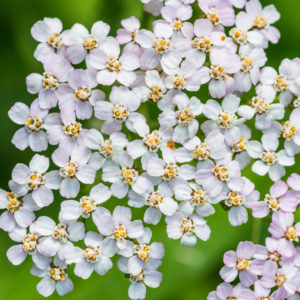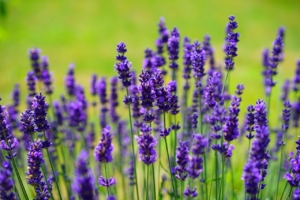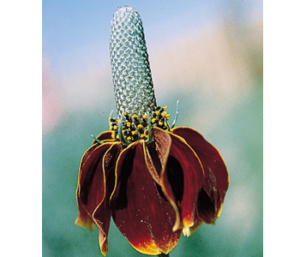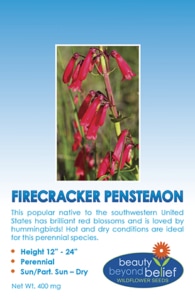My 10 Favorite Drought Tolerant Plants
Plants For a Tight Water Budget
By Heather Stone
Here in Colorado, our summers are often hot and dry and there’s often some sort of “watering restrictions” in place. Those two words can bring just about any gardener to their knees. But, you can still have a garden filled with beautiful flowers even if you’re on a tight water budget. In my Zone 5 garden, these plants perform well whether we have a temporary or longer-term drought situation.
Yarrow- Achillea
This long-blooming perennial comes in a rainbow of colors (pink, white, red, orange and yellow). The colorful blossoms are attractive to butterflies and make a good cut flower. Yarrow is hardy in Zones 3-9 and is best planted in full sun.
Lavender- Lavandula

Photo courtesy of Hans / pixabay
This native Mediterranean plant is accustomed to dry, sunny conditions. The beautiful purple flower spikes look great on their own or in the border. Lavender is prized for its fragrance and medicinal properties and is attractive to many pollinators. Hardy in Zones 5-10.
Sedum –Sedum spp.
There are many varieties of sedum from upright to low growing groundcovers. They are sure to fit in just about any garden design from the back of the border to the rock garden. These easy to grow plants need little care once established. Hardy in Zones 3-9.
Coneflower –Echinacea spp.
These beautiful, long blooming perennials are not only drought tolerant but will thrive in almost any soil and often self-sow. The blossoms are attractive to both butterflies and birds. The goldfinches love to eat the seed. There are several species and many varieties of this rugged plant with flowers in many shapes, sizes and colors. Don’t leave this trusty plant out of the drought-tolerant garden.
Soapwort- Saponaria spp.
A profusion of pink blooms covers this low growing plant for weeks in the spring attracting many bees and butterflies. This hardy evergreen plant grows best in Zones 3-8. Soapwort was used by the early settlers to make soap.
Mexican Hat- Ratibida columnifera
This sun-loving wildflower is both long-lived and long blooming and thrives in dry conditions. The dark red blossoms look great planted in masses, attracting many bees and butterflies. Mexican hat is both a great cut and dried flower. Hardy in Zones 4-8.

Veronica spp.
Covered in blue, purple, white or pink flowers for weeks in spring or mid-summer this long blooming perennial comes in a variety of sizes. Clump forming varieties look great along the edge of the garden or the groundcovers really make a statement in the spring when covered in a mass of blue flowers. Plant in full sun. Hardy to Zones 3-9.
Beardtongues- Penstemon spp.
Native to most parts of North America Penstemons are a great choice for the dry garden. Their flowers are attractive to many pollinators and come in a variety of colors, sizes, shapes and bloom times. Some excellent choices for the dry garden include Penstemon Mexicali, P. pinifolius, P. eatonii, P. strictus.
Catmint- Nepeta spp.
Catmint is a show stopper, blooming from early spring to early fall. The fragrant blue-purple flowers are attractive to many pollinators. This nearly indestructible plant is both deer and rabbit resistant and thrives in full sun in Zones 4-9.
ILLITERATE GARDEN
Garden Problems We All Have
By: Sandy Swegel
“My garden is illiterate. It didn’t read the book about what it can’t do.”
That was the wisecracking opening remark at a gardening talk I attended recently. We all laughed and during the break we started talking about some of the stupidest plants we know.
Looking at wild plants, we laughed about orchids native to cold, arid Colorado. But the most illiterate plants are the ones we humans planted because we didn’t know better.
The plants that don’t know they can’t survive in Zone 5.
Pineapple sage don’t you know anything? You like living in semi-tropics. What are you doing living another year in the Colorado clay soil iris garden with 70 mph winds?
The plants that don’t know that being an annual means can’t live longer than one year.
Yep Verbena bonariensis I’m talking about you. The books say you are an annual but I’ve watched you survive for three years in a row. Ditto snapdragons…I have trees younger than you.
Plants that don’t know they are supposed to be invasive.
I’m waiting for you, bamboo. Any day now you’re supposed to fill in that entire border between my yard and my neighbor’s ugly garage. Sure, four years ago I saw one runner into the grass…but what have you done lately?
Codependent plants.
These are the plants that not only don’t know they can’t survive but also put up with terrible abuse. Don’t be sweet-talking me Japanese Maple. You know who you are. You croaked all those times I planted you in protected areas and nurtured you with extra mulch in winter and water in summer. But the year I put you, a tree, in a pot with six other plants on a third-floor deck without protection from the cold and without winter watering…that’s the year you survive?
If it were up to humans, we’d never have surprises in the garden or tulips blooming in July or scabiosa blooming in December literally under the snow. Or the gallardia that blooms in my driveway. We won’t even mention the weed that seeded and bloomed in my truck bumper the December I was driving around Louisiana.
What a relief that our plants are so darn illiterate.
Photocredits:
fullycoolpix.blogspot.com/2014/08/plants-live-everywhere.html
www.boredpanda.com/plants-flowers-versus-concrete-asphalt-pavement/
The Windy Garden
Building a Wind Resistant Garden
By: Sandy Swegel
This could be a perfectly beautiful early Spring. We’ve had a week of warm sunny weather that is waking up the daffodils and tulips. Birds are flitting about and energetically singing out mating calls. It’s a joyful break from dark winter days. But then there’s the wind. Chinook winds. Or as they were called the year I lived in the Alps, “scheiss foen.” Everyone understood if the foen had arrived that you could be in a foul mood because of the irritability and headaches from the air pressure changes these mountain-made winds caused.
Wind can have devastating effects on a garden. Sure the strong winds can break stems and tree branches, but the greatest stressors comes from the drying effects of the winds. Plants close their stomata (leaf pores) to reduce water loss, but that slows the plants’ ability to grow. The winds desiccate the plant tissue and dry out the top inches of the soil meaning the plants need more water. Even plants under snow cover can get very drought stressed because the winds evaporate the snow before it can melt.
If it’s going to be a windy season, I make a few mental changes in my garden plans. Here’s things to consider if you have a windy garden:
Use more drought tolerant plants.
Increase your watering after the winds die down.
Grow shorter plants.
Grow plants like lavender with thinner leaves that won’t desiccate so easily.
Plant some tall ornamental grasses through the flower garden. They look beautiful in the wind and provide some wind break protection.
Plant evergreens as windbreaks.
Consider a garden wall.
And take an aspirin for your sinus headache.
Photocredits:
http://clarenbridgegardencentre.ie/
Top Tips for Windy Gardens
http://www.pc.gc.ca/pn-np/ab/waterton/ne/ne-galerie-gallery-2.aspx?a=1&photo=%7Bdfae32e8-4d1e-47e4-a909-08c9ea68dd13%7D
Crevice Gardens
By: Sandy Swegel
Some crevice gardens look like regular gardens where flowering plants cover all the rocks. Others look more like rocky alpine mountainsides. The Denver Botanic Gardens latest crevice gardens combine sculptural placement of the rocks with native plants.
So keep at eye out for a crevice garden near you. Botanic Gardens around the world are investing millions of dollars installing crevice gardens that highlight the art of stone and alpine gardens, and that provide us with ideas of how we will keep growing beautiful plants and flowers even as global warming reduces our available water in some places.
Photo credits :
www.nargs.org
www.rockstarplants.com/
www.architectureartdesigns.com/18-effective-ideas-how-to-make-small-outdoor-seating-area/
www.yampariverbotanicpark.org/gardens.php
Start Your 4th of July Party Now
Firecracker Penstemon
By: Sandy Swegel
Get your Fireworks and start your 4th of July party now. One of my favorite things about perennials is that you plant them once and they bloom year after year. Their appearance every year becomes one of the sweet rituals of the garden. Bright red Firecracker Penstemon is a favorite neighborhood ritual of mine. Some 15 years ago an older lady in the neighborhood planted red firecracker penstemons around her mailbox on the street. She called it the 4th of July flower because the little stand of 3- ft tall red flowers that had grown around her mailbox in the hot beating sun were always in bloom on the 4th of July. Over time, the display got more elaborate as purple salvia were planted at the base of the penstemon. Later white alyssum was growing all around in the rocks. It was a true red white and blue extravaganza.
A few years later I noticed other mailboxes in this suburban neighborhood had firecracker penstemons growing up around them. The whole street was decorated for the 4th of July. I never did find out if everyone liked the idea and planted penstemon too or if some middle of the night guerilla gardener spread penstemon seed everywhere.
Firecracker penstemon is a good choice for mailboxes in the sun next to the street because it tolerates high heat and drought which both plague mailboxes in the sun next to concrete sidewalks. The only caveat is that penstemon is one of those perennials that doesn’t bloom until its second year, so you’ll have to wait a bit for the start of your annual your 4th of July explosion of red.
Photocredits:
https://nargs.org/forum/penstemon-eatoni-eaton-firecracker-or-firecracker-penstemon
http://extension.usu.edu/rangeplants/htm/firecracker-penstemon
Drought again?!
Gardening Tips
by Sandy Swegel
Unseasonably warm weather means I finally had time to get some more bulbs planted this week. It has been warm and sunny this fall but I didn’t fully realize how drought had snuck up on us until I went to dig the deep holes for the daffodils. In decent garden soil that has had regular if modest irrigation all year, the soil below six inches was dry dry dry. Pulverized dirt dry. During times of drought, the soil all over dries down. The water table recedes and deep-rooted trees and grasses have used up whatever water is available. We can keep irrigating with an inch of water a week on the surface, but it’s not possible to water enough to keep the soil moist deep in the ground if there’s no natural rainfall.
Drought really snuck up on lots of the US this year. Except for poor southern California, most of the country started the year with good water. Now significant parts of the plains and southeast (as well as southern California which started the year dry) are experiencing moderate to severe drought. See the drought monitor for your area. http://droughtmonitor.unl.edu In my area, we went from an awesome spring to virtually no rain since July.
So what’s happening in your garden now? Here’s what happens in moderate drought:
Soil with clay in it turns hard and cracks open. (The clay shrinks when it dries out.)
Soil critters go into self-preservation mode. During times of drought, they have varying survival techniques from as simple as laying eggs for the next generation once conditions improve. Earthworms go into a hibernation-like state called estivation. Balled up little earthworms are what I found in my garden bed when I was planting bulbs.
What can you do besides pray for rain or snow or freeze?
Give your trees and shrubs a good long slow-watering now. Trees need 10 gallons of water per inch of trunk diameter once a month. If your irrigation is still turn on, you can run it longer than usual. Or put a light sprinkler on for several hours. Here’s a great fact-sheet on ways to water trees during drought. http://www.colostate.edu/Dept/CoopExt/4dmg/Trees/caring.htm
Otherwise, leave the soil alone. Digging in too dry soil ruins soil texture just like digging in too wet soil. The soil I had dug for the daffodils was like dust when I filled the holes back in.
Pay attention to rain or snow this month. If you aren’t getting significant precipitation, water the trees and shrubs once a month even if the ground is frozen.
And pray for rain.
Bird Baths
Eight critters you can find in your bird baths
by Sandy Swegel
Cute little birds hatched out of a nest in my roof eaves this spring so I decided to put a bird bath in the front yard so I could watch strategically from the window. I didn’t have traditional bird baths so shallow stone bowls on the ground had to make do. It’s been a couple of months and I have yet to see the birds in the bath although they may splash about when I’m not home. I have discovered lots of critters need water in the heat of summer. Here’s who shows up if you have a water source in your yard.
8. Wasps
OK, so they’re not my favorite although they have an important role in the garden. Wasps aren’t just insatiably thirsty, the water is crucial for keeping their nests cool.
7. Mosquito Larvae
Duh…standing water attracts mosquitoes. Since West Nile is prevalent around here, I empty out the water whenever I see the tiny larvae swimming around.
6. Raccoons
Fortunately, we don’t have too many raccoons in my yard, but if the birdbath is all muddy or knocked over, it’s a sign the raccoons were there.
5. Bunnies
We have a bunny overpopulation this year. Officially, I hate them. They chow down on young garden plants and my favorite flowers. Secretly they are so cute. It’s been so hot and dry who could deny a baby rabbit a sip of water. I guess the baby squirrels can drink too.
4. Bees
I always make sure there are rocks in my bird bath for the bees to stand on so they don’t drown. Bees need lots of water for digestion and to cool the hive.
3. Butterflies
Be sure to have nice shallow water to attract butterflies. These are so delightful! Even the cabbage moths are cute.
2. All the other mammals
Neighborhood dogs, deer taking a break from eating your flowers. If it’s a big enough bird bath, you might get a bear or two in bear country. My friends used a motion detector night camera to catch a bobcat drinking from their little water pond.
1. And finally birds!
Photos:
http://www.scoontemplations.com/2012/06/bunny-with-death-wish.html
http://hillsidegardencenter.com
http://animalwall.xyz/bird-bath-fun-water-hd-background/
Nurse Rock
Gardening Tips
by Sandy Swegel
Sometimes there’s a difficult spot in a garden when plants just keep failing. Or sometimes there’s a plant you really want in your garden (you know who you are butterfly weed) that keeps dying even though you think you are giving it perfect conditions. The easy thing to do is give up and plant a different plant or in a different place. But the determined gardener can reach into her magic toolbox of helpers for a Nurse Rock to give her plant the extra edge.
What is a nurse rock? Basically, it’s just a rock…most any old rock…that you strategically plant with your new plant. In hot arid Colorado, I usually plant on the north side of the rock so there’s just a bit more water and shade for the young plant. I learned about nurse rocks from a gardening friend who liked to grow the native plants she saw when she was out hiking. In nature, you’ll often see that plants are more likely to be growing near rocks rather than out in the open field. Even in your own suburban garden, you’ll see the edges of your beds or even your sidewalks have more robust plants.
There have been many scientific studies about why plants do better with nurse rocks. The obvious speculations are improved water, improved drainage, protection from sun, space from other plants, protection from wildlife, less evaporation, better soil nutrients under rocks and even more mycorrhizae. Old garden folklore highlights the image of the rock as a protector of the young plant from the big world.
I encourage you to give it a try. In the wild, nurse rocks are often large rocks a foot or more high. In the home garden, I’ve found even a small rock that fits easily in my hand gives a plant an edge. I’m trying this week with a spot in a narrow garden bed that just has had several different plants die out despite our ministrations. We’ve come up with reasons why the plants die…that one spot gets a little more sun and it a tiny bit higher than surrounding soil, or it’s a good hiding place for the bunny who ate the beautiful fall anemone down to stubs. We’re going to try again with an adorable small upright clematis, Sugar Bowl, and a good baseball sized nurse rock planted at its base. Thank you nurse rock.
Photos:
http://www.highcountrygardens.com/perennial-plants/unique-plants/clematis-scottii
http://www.laspilitas.com/classes/native_planting_guide.html
http://eachlittleworld.typepad.com/each_little_world/2008/12/
The Aster
Wildflower Seeds
by Sandy Swegel
July is when the aster begins to shine in the garden. We were walking around a hot drought xeric garden yesterday where many flowering plants were going to seed (ah, flax and larkspur we miss your blues already) or had complete browned and been cut back (goodbye poppies). Amid the browning foliage, there were splashes of color we forget about each year like the amazing Zinnia grandiflora, a very short aster, native to plains and foothills, that thrives along hot concrete walkways.
Standing near this tiny aster, we could look up to the back of the garden where there was a bit of shade and moisture and see tall asters in full bud. In the sunny grassy open space nearby, purple asters had already bloomed and were feeding pollinators and butterflies. We looked to a neighbor’s irrigated garden and saw a splendid patch of Michaelmas daisies ready to bloom with hundreds of flowers. Aster may have small individual flowers, but they cram dozens of flowers onto each flower stalk.
Asters aren’t very picky about location and in cities, you’ll see they seed themselves into alleys and sometimes into your flower beds. In fields, the purple asters often grow one plant here and one there out among uncut grasses.
The very best thing about asters: butterflies love them. And we definitely want to keep the butterflies happy.
Photos and information:
http://swbiodiversity.org/seinet/taxa/index.php?taxon=1961

